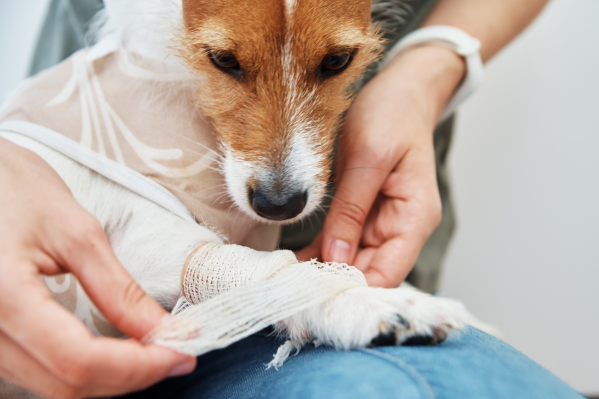Seeing our furry friends in pain can cause a lot of stress, and it can be especially scary if they're bleeding.
Being an informed pet parent and knowing first aid can give your pet a higher chance of recovery, and in extreme cases, even save their life.
We spoke with Dr. Yui Shapard, BVM&S, MRCVS and medical director at Pawp to understand the most common causes of bleeding in pets, what to do if your dog or cat is bleeding, and when to take them to the vet for treatment.
Common causes of bleeding in pets
The most common causes of bleeding in pets include direct trauma from dog bites and motor-vehicular accidents, and coagulopathy disorder. Examples of coagulopathy often seen in veterinary medicine are IMHA (immune-mediated hemolytic anemia), ITP (immune-mediated thrombocytopenia), toxin/poison ingestion affecting the body's ability to clot (e.g. rat bait ingestion), or when a pet is in a dangerous emergency situation called DIC (Disseminated Intravascular Coagulation). DIC is caused by a multitude of ailments including but not limited to poison/toxin, pancreatitis, snake bite, cancer such as hemangiosarcoma, renal disease, heat stroke, trauma, GDV (gastric dilatation volvulus), heartworm disease, endotoxemia, leishmaniasis, babesiosis, canine parvo, canine distemper, heart failure, leptospirosis, acute hemorrhagic diarrhea syndrome (previously known as HGE—hemorrhagic gastroenteritis), protein-losing enteropathy, bacterial endocarditis, systemic lupus erythematosus, immune-mediated polyarthritis, and more.
"Usually by the point that a pet is in DIC, their prognosis is extremely poor," explains Dr. Shapard. "This is also why we do not take spontaneous bruising or bleeding lightly, and early veterinary intervention could literally be life or death."
What should I do if my pet is bleeding?
If your pet is bleeding, attempt to stop the bleeding if possible by placing direct pressure on the site. This can be done by placing a compress of gauze or clean cloth directly over the wound.
"I do not recommend any attempts to tie off the blood circulation, as this may cause more harm than good and potentially complicate the veterinary care the pet will need," explains Dr. Shapard.
It's imperative that the pet is taken straight to an emergency facility immediately if the bleeding does not stop despite direct pressure or there's active and ongoing blood loss.
Depending on where the pet is bleeding from, and if it involves large blood vessels, direct pressure will be unlikely to be helpful. However, if it's a superficial laceration and the wound is not deep, then direct pressure should mitigate further blood loss.
You may want to consider muzzling your pup or having someone restrain them prior to handling their injury. Even the nicest dogs can get scared and potentially bite when they're in pain.
Should I take my pet to the vet for bleeding?
Take your pet to the vet if there's constant, consistent blood loss that is more than just oozing. Consistent dripping of blood that does not stop despite direct pressure to attempt at hemostasis or constant flow or pouring of blood needs immediate veterinary intervention to avoid further blood loss.
"If the bleeding was spontaneous and appeared to have come from nowhere and is also accompanied with abnormal changes in your pet's demeanor, it's best to be safe and take their pet into veterinary care immediately," explains Dr. Shapard.
We also recommend that pet parents keep pet first aid kits handy in case of an emergency. If you have questions about the best next steps for your pet, reach out to the team of experts at Pawp—we are here 24/7 to point you in the right direction.
